The global fumigation drone market is valued at USD 271.6 million in 2025 and projected to reach USD 602.7 million by 2035, expanding at a CAGR of 8.3% and recording total growth of 121.9%. The fumigation drone market size is expected to increase by nearly 2.22X, supported by the convergence of precision agriculture, automation in pest management, and the push toward efficiency in forestry and large-scale farming. Key trends define how adoption evolves across technology, regulation, and industry application.
Adoption of precision agriculture techniques is a defining trend. Farmers are increasingly shifting toward data-driven management practices where fumigation drones deliver targeted spraying with reduced chemical use. This trend is supported by the integration of GPS navigation, real-time mapping, and multi-sensor payloads that optimize coverage across varying terrains. The ability to reduce wastage while enhancing effectiveness is making drones a preferred choice over manual spraying and conventional machinery in both smallholder farms and industrial plantations. Automation and efficiency gains drive adoption in large-scale farming operations. Drone-based fumigation provides coverage of large fields in shorter timeframes, reducing dependency on manual labor while ensuring uniform distribution of chemicals. Battery capacity improvements and swappable payload systems are enabling higher operational efficiency, with some models now capable of multiple sorties per day. This efficiency trend strengthens demand in regions facing labor shortages or high labor costs, particularly across the Asia Pacific and Europe.
Technology convergence with digital farming platforms represents another major trend. Drones are being integrated into broader farm management ecosystems that combine satellite imaging, IoT sensors, and predictive analytics. This convergence allows fumigation drones to act not only as applicators but as part of a continuous feedback loop where real-time data informs future spraying patterns. Partnerships between drone manufacturers and agri-tech platforms are expanding, linking fumigation drones with precision irrigation and crop health monitoring systems. Forestry and non-traditional applications are emerging as secondary growth drivers. Beyond agriculture, fumigation drones are being adopted in forestry management for pest control and in quarantine measures for invasive species. Urban green space management, including pest treatment in public parks and golf courses, also demonstrates growing potential. These applications extend the fumigation drone market beyond farming, widening the demand base.
Regulatory adaptation and safety protocols influence adoption cycles. Governments are gradually updating rules to allow larger payload drones and extended flight ranges, enabling commercial scalability. Countries in Asia Pacific, particularly China and India, are adopting supportive frameworks, while North America and Europe emphasize safety and environmental impact assessments.
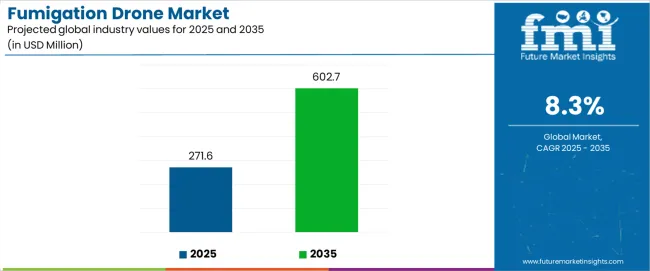
Between 2025 and 2030, the fumigation drone market is projected to expand from USD 271.6 million to USD 404.6 million, resulting in a value increase of USD 133.0 million, which represents 40.2% of the total forecast growth for the decade. This phase of development will be shaped by increasing adoption of precision agriculture technologies, rising demand for large payload capacity drones, and growing emphasis on automated crop protection systems with enhanced efficiency characteristics. Agricultural service providers are expanding their drone fleet capabilities to address the growing demand for pest control applications, disease management, and specialty crop treatment requirements.
| Metric | Value |
|---|---|
| Estimated Value in (2025E) | USD 271.6 million |
| Forecast Value in (2035F) | USD 602.7 million |
| Forecast CAGR (2025 to 2035) | 8.3% |
From 2030 to 2035, the fumigation drone market is forecast to grow from USD 404.6 million to USD 602.7 million, adding another USD 198.1 million, which constitutes 59.8% of the overall ten-year expansion. This period is expected to be characterized by the expansion of autonomous flight technologies, the integration of ai-powered spraying systems, and the development of multi-functional drone platforms with enhanced precision capabilities. The growing adoption of smart farming practices will drive demand for fumigation drones with superior navigation systems and compatibility with farm management software across agricultural operations.
Between 2020 and 2025, the fumigation drone market experienced robust growth, driven by increasing demand for modern agricultural practices and growing recognition of drone technology as an essential tool for efficient crop protection across large-scale farming, orchard management, and forestry applications. The fumigation drone market developed as farmers recognized the potential for drones to reduce pesticide usage while maintaining crop protection effectiveness and enabling cost-effective treatment protocols. Technological advancement in GPS guidance systems and precision spraying mechanisms began emphasizing the critical importance of maintaining application accuracy and coverage consistency in diverse agricultural environments.
Market expansion is being supported by the increasing global demand for precision agriculture solutions and the corresponding need for automated systems that can provide superior application accuracy and coverage efficiency while enabling reduced chemical usage and environmental impact across various farming and forestry management applications. Modern agricultural operations and crop protection specialists are increasingly focused on implementing drone technologies that can deliver targeted treatments, prevent crop damage, and provide consistent application performance throughout complex terrain and diverse crop conditions. Fumigation drones' proven ability to deliver exceptional precision against pest infestations, enable time-efficient operations, and support cost-effective treatment protocols make them essential tools for contemporary farming and agricultural service operations.
The growing emphasis on agricultural efficiency and environmental protection is driving demand for fumigation drones that can support large-scale farming requirements, improve crop yield outcomes, and enable automated application systems. Farmers' preference for technology that combines effective pest control with operational speed and resource efficiency is creating opportunities for innovative drone implementations. The rising influence of smart agriculture and precision farming practices is also contributing to increased demand for fumigation drones that can provide GPS-guided applications, real-time monitoring capabilities, and reliable performance across extended operational periods.
The fumigation drone market is poised for rapid growth and transformation. As industries across agriculture, forestry, horticulture, and pest control seek solutions that deliver exceptional application precision, operational efficiency, and environmental compliance, fumigation drones are gaining prominence not just as specialized equipment but as strategic enablers of modern farming practices and crop protection.
Rising precision agriculture adoption in Asia-Pacific and expanding smart farming initiatives globally amplify demand, while manufacturers are leveraging innovations in payload capacity systems, autonomous flight controls, and integrated sensor technologies.
Pathways like high-payload drone platforms, ai-powered application systems, and specialized crop treatment solutions promise strong margin uplift, especially in large-scale agricultural segments. Geographic expansion and technology integration will capture volume, particularly where local agricultural practices and precision farming adoption are critical. Regulatory support around agricultural modernization, pesticide reduction requirements, and farming efficiency standards give structural support.
The fumigation drone market is segmented by payload capacity, application, technology type, end-use sector, and region. By payload capacity, the fumigation drone market is divided into ≥40kg and <40kg categories. By application, it covers farms, orchards, gardens and woods, and others. By technology type, the fumigation drone market includes GPS-guided systems, autonomous flight platforms, and manual control systems. By end-use sector, it is categorized into commercial agriculture, agricultural services, government agencies, and individual farmers. Regionally, the fumigation drone market is divided into North America, Europe, East Asia, South Asia & Pacific, Latin America, and the Middle East & Africa.
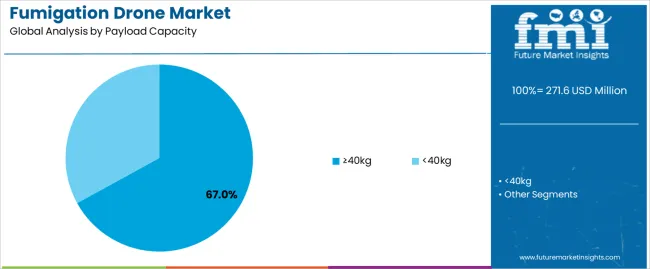
The ≥40kg payload capacity segment is projected to account for 67.0% of the fumigation drone market in 2025, reaffirming its position as the leading capacity category. Large-scale farming operations and agricultural service providers increasingly utilize high-payload fumigation drones for their superior field coverage capabilities when operating across extensive agricultural areas, excellent operational efficiency characteristics, and cost-effectiveness in applications ranging from crop protection to large-area pest control management. High-payload fumigation drone technology's advanced spraying system capabilities and extended flight duration directly address the industrial requirements for comprehensive coverage in large-scale agricultural environments.
This capacity segment forms the foundation of modern commercial agricultural operations, as it represents the drone type with the greatest operational efficiency and established market demand across multiple application categories and farming sectors. Manufacturer investments in enhanced battery technologies and automated refilling compatibility continue to strengthen adoption among agricultural contractors and large farming enterprises. With companies prioritizing operational efficiency and coverage optimization, high-payload fumigation drones align with both performance requirements and economic efficiency objectives, making them the central component of comprehensive agricultural automation strategies.
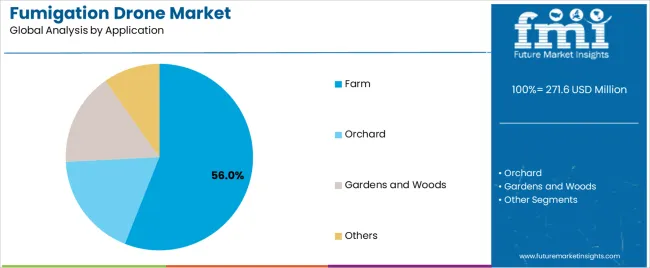
Farm applications are projected to represent 56.0% of fumigation drone demand in 2025, underscoring their critical role as the primary agricultural consumers of precision drone technology for crop protection, pest management, and agricultural treatment applications. Farm operators prefer fumigation drones for their exceptional application precision capabilities, time-saving operational characteristics, and ability to reduce chemical usage while ensuring effective pest control throughout diverse crop protection programs. Positioned as essential equipment for modern farming operations, fumigation drones offer both efficiency advantages and environmental compliance benefits.
The segment is supported by continuous innovation in precision spraying technologies and the growing availability of specialized application systems that enable variable rate applications with enhanced coverage uniformity and rapid field treatment capabilities. Additionally, farm operators are investing in fleet management systems to support large-scale drone utilization and operational planning. As precision agriculture demand becomes more prevalent and farming efficiency requirements increase, farm applications will continue to dominate the end-use market while supporting advanced agricultural automation utilization and crop protection strategies.
The fumigation drone market is advancing rapidly due to increasing demand for precision agriculture technologies and growing adoption of automated crop protection solutions that provide superior application accuracy and operational efficiency while enabling reduced chemical usage across diverse farming and agricultural management applications. However, the fumigation drone market faces challenges, including high initial equipment costs, regulatory compliance requirements, and the need for specialized operator training and certification programs. Innovation in autonomous flight capabilities and ai-powered application systems continues to influence product development and market expansion patterns.
The growing adoption of autonomous flight systems, ai-powered pest detection algorithms, and machine learning-based application optimization is enabling manufacturers to produce advanced fumigation drones with superior decision-making capabilities, enhanced operational precision, and automated treatment protocol functionalities. Advanced autonomous systems provide improved application accuracy while allowing more efficient field coverage and consistent performance across various crop types and terrain conditions. Manufacturers are increasingly recognizing the competitive advantages of autonomous drone capabilities for operational differentiation and premium market positioning.
Modern fumigation drone producers are incorporating IoT connectivity, cloud-based data management, and integrated field monitoring systems to enhance operational intelligence, enable predictive maintenance capabilities, and deliver value-added solutions to agricultural customers. These technologies improve farming efficiency while enabling new operational capabilities, including real-time application monitoring, treatment effectiveness tracking, and reduced operational overhead. Advanced data integration also allows manufacturers to support comprehensive farm management systems and agricultural modernization beyond traditional manual application approaches.
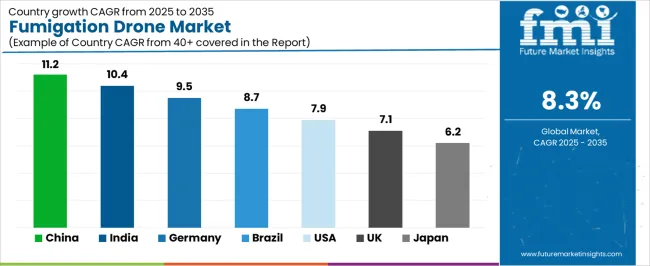
| Country | CAGR (2025-2035) |
|---|---|
| China | 11.2% |
| India | 10.4% |
| Germany | 9.5% |
| Brazil | 8.7% |
| USA | 7.9% |
| UK | 7.1% |
| Japan | 6.2% |
The fumigation drone market is experiencing strong growth globally, with China leading at an 11.2% CAGR through 2035, driven by the expanding agricultural modernization programs, growing precision farming adoption, and significant investment in drone technology development. India follows at 10.4%, supported by government initiatives promoting agricultural technology, increasing farm mechanization demand, and growing crop protection requirements.
Germany shows growth at 9.5%, emphasizing precision agriculture innovation and advanced farming technology development. Brazil records 8.7%, focusing on large-scale agricultural expansion and commercial farming modernization. The USA demonstrates 7.9% growth, prioritizing agricultural efficiency standards and farming automation excellence. The UK exhibits 7.1% growth, emphasizing agricultural technology adoption and precision farming development. Japan shows 6.2% growth, supported by high-tech agriculture initiatives and precision farming concentration.
The report covers an in-depth analysis of 40+ countries top-performing countries are highlighted below.
Revenue from fumigation drones in China is projected to exhibit exceptional growth with a CAGR of 11.2% through 2035, driven by expanding agricultural modernization programs and rapidly growing precision farming adoption supported by government initiatives promoting agricultural technology development. The country's strong position in drone manufacturing and increasing investment in smart agriculture infrastructure are creating substantial demand for advanced fumigation drone solutions. Major agricultural cooperatives and farming enterprises are establishing comprehensive drone operation capabilities to serve both domestic crop protection demand and agricultural efficiency markets.
Revenue from fumigation drones in India is expanding at a CAGR of 10.4%, supported by the country's massive agricultural sector, expanding government support for farm modernization, and increasing adoption of precision agriculture solutions. The country's initiatives promoting agricultural technology and growing farmer awareness are driving requirements for advanced crop protection capabilities. International suppliers and domestic manufacturers are establishing extensive production and service capabilities to address the growing demand for fumigation drone products.
Revenue from fumigation drones in Germany is expanding at a CAGR of 9.5%, supported by the country's advanced precision agriculture capabilities, strong emphasis on farming technology innovation, and robust demand for high-performance agricultural automation in crop protection and farm management applications. The nation's mature agricultural sector and efficiency-focused operations are driving sophisticated fumigation drone systems throughout the farming industry. Leading manufacturers and technology providers are investing extensively in autonomous systems and precision application technologies to serve both domestic and international markets.
Revenue from fumigation drones in Brazil is growing at a CAGR of 8.7%, driven by the country's expanding agricultural sector, growing commercial farming operations, and increasing investment in agricultural technology development. Brazil's large agricultural area and commitment to farming modernization are supporting demand for efficient fumigation drone solutions across multiple crop production segments. Manufacturers are establishing comprehensive service capabilities to serve the growing domestic market and agricultural export opportunities.
Revenue from fumigation drones in the USA is expanding at a CAGR of 7.9%, supported by the country's advanced agricultural technology sector, strategic focus on farming efficiency, and established precision agriculture capabilities. The USA's agricultural innovation leadership and technology integration are driving demand for fumigation drones in commercial farming, specialty crop production, and agricultural service applications. Manufacturers are investing in comprehensive technology development to serve both domestic agricultural markets and international specialty applications.
Revenue from fumigation drones in the UK is growing at a CAGR of 7.1%, driven by the country's focus on agricultural technology advancement, emphasis on farming efficiency, and strong position in precision agriculture development. The UK's established agricultural innovation capabilities and commitment to farming modernization are supporting investment in advanced fumigation technologies throughout major agricultural regions. Industry leaders are establishing comprehensive technology integration systems to serve domestic farming operations and specialty agricultural applications.
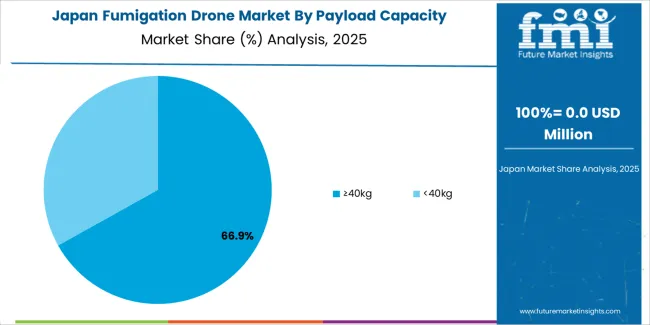
Revenue from fumigation drones in Japan is expanding at a CAGR of 6.2%, supported by the country's high-tech agriculture initiatives, growing precision farming sector, and strategic emphasis on agricultural automation development. Japan's prestige technology capabilities and integrated agricultural systems are driving demand for advanced fumigation drones in specialty crop production, precision agriculture, and high-value agricultural applications. Leading manufacturers are investing in specialized capabilities to serve the stringent requirements of high-tech agriculture and precision farming industries.
The fumigation drone market in Europe is projected to grow from USD 54.3 million in 2025 to USD 120.5 million by 2035, registering a CAGR of 8.3% over the forecast period. Germany is expected to maintain its leadership position with a 35.2% market share in 2025, declining slightly to 34.8% by 2035, supported by its strong precision agriculture sector, advanced farming technology capabilities, and comprehensive agricultural automation industry serving diverse fumigation drone applications across Europe.
France follows with a 18.5% share in 2025, projected to reach 19.0% by 2035, driven by robust demand for fumigation drones in wine production, agricultural modernization programs, and precision farming applications, combined with established agricultural technology infrastructure and specialty crop expertise. The United Kingdom holds a 16.8% share in 2025, expected to reach 17.2% by 2035, supported by strong agricultural technology sector and growing precision farming activities.
Italy commands a 12.5% share in 2025, projected to reach 12.8% by 2035, while Spain accounts for 9.2% in 2025, expected to reach 9.5% by 2035. The Netherlands maintains a 4.8% share in 2025, growing to 5.0% by 2035. The Rest of Europe region, including Nordic countries, Eastern Europe, Belgium, Poland, and other nations, is anticipated to maintain momentum, with its collective share moving from 3.0% to 1.7% by 2035, attributed to increasing agricultural modernization in Eastern Europe and growing precision farming penetration in Nordic countries implementing advanced agricultural technology programs.
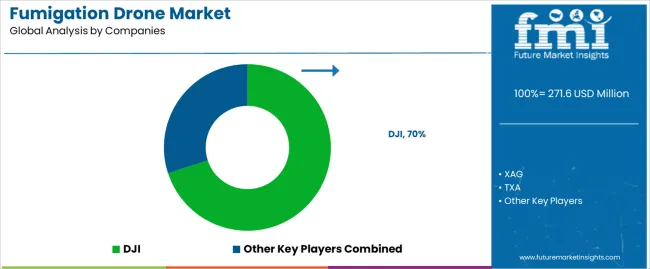
The fumigation drone market is characterized by competition among established drone manufacturers, specialized agricultural technology producers, and integrated precision agriculture solutions providers. Companies are investing in autonomous flight technology research, payload capacity optimization, precision spraying system development, and comprehensive product portfolios to deliver consistent, high-performance, and application-specific fumigation drone solutions. Innovation in ai-powered systems, GPS guidance integration, and operational efficiency enhancement is central to strengthening market position and competitive advantage.
DJI leads the fumigation drone market with a strong market share, offering comprehensive fumigation drone solutions including advanced flight control systems with a focus on agricultural and commercial applications. XAG provides specialized agricultural drone capabilities with an emphasis on precision spraying systems and automated field operations. TXA delivers innovative crop protection products with a focus on high-payload platforms and commercial agricultural services. Hanhe specializes in agricultural automation and fumigation drone technologies for large-scale farming applications. TTA focuses on precision agriculture equipment and integrated farming solutions. Harris Aerial offers specialized drone platforms with emphasis on commercial agricultural and forestry applications.
| Items | Values |
|---|---|
| Quantitative Units (2025) | USD 271.6 Million |
| Payload Capacity | ≥40kg, <40kg |
| Application | Farm, Orchard, Gardens and Woods, Others |
| Technology Type | GPS-Guided Systems, Autonomous Flight Platforms, Manual Control Systems |
| End-Use Sector | Commercial Agriculture, Agricultural Services, Government Agencies, Individual Farmers |
| Regions Covered | North America, Europe, East Asia, South Asia & Pacific, Latin America, Middle East & Africa |
| Countries Covered | China, India, Germany, Brazil, United States, United Kingdom, Japan and 40+ countries |
| Key Companies Profiled | DJI, XAG, TXA, Hanhe, TTA, and Harris Aerial |
| Additional Attributes | Dollar sales by payload capacity and application category, regional demand trends, competitive landscape, technological advancements in autonomous flight systems, precision spraying development, AI integration innovation, and agricultural service integration |
The global fumigation drone market is estimated to be valued at USD 271.6 million in 2025.
The market size for the fumigation drone market is projected to reach USD 602.7 million by 2035.
The fumigation drone market is expected to grow at a 8.3% CAGR between 2025 and 2035.
The key product types in fumigation drone market are ≥40kg and <40kg.
In terms of application, farm segment to command 56.0% share in the fumigation drone market in 2025.






Full Research Suite comprises of:
Market outlook & trends analysis
Interviews & case studies
Strategic recommendations
Vendor profiles & capabilities analysis
5-year forecasts
8 regions and 60+ country-level data splits
Market segment data splits
12 months of continuous data updates
DELIVERED AS:
PDF EXCEL ONLINE
Fumigation Product Market Size and Share Forecast Outlook 2025 to 2035
Fumigation Service Market Size and Share Forecast Outlook 2025 to 2035
Drone Simulator Market Size and Share Forecast Outlook 2025 to 2035
Drones For Emergency Responders Market Size and Share Forecast Outlook 2025 to 2035
Drone Inspection and Monitoring Market Size and Share Forecast Outlook 2025 to 2035
Drone Cybersecurity Market Size and Share Forecast Outlook 2025 to 2035
Drone Logistics & Transportation Market Size and Share Forecast Outlook 2025 to 2035
Drone Warfare Market Size and Share Forecast Outlook 2025 to 2035
Drone Analytics Market Size and Share Forecast Outlook 2025 to 2035
Drone Battery Market Size and Share Forecast Outlook 2025 to 2035
Drone Delivery Service Market Analysis by Delivery Distance, Propeller Type, End User, and Region, and Forecast from 2025 to 2035
Drone Sensor Market - UAV Advancements & Forecast 2025 to 2035
Drone Motor Market Growth - Trends & Forecast 2025 to 2035
Toy Drones Market Size and Share Forecast Outlook 2025 to 2035
Anti-Drone Technology Market
LiDAR Drone Market Size and Share Forecast Outlook 2025 to 2035
Counter Drone System Market Size and Share Forecast Outlook 2025 to 2035
Medical Drones Market Report – Growth & Forecast 2025-2035
Tethered Drone Market Size and Share Forecast Outlook 2025 to 2035
Consumer Drones Market

Thank you!
You will receive an email from our Business Development Manager. Please be sure to check your SPAM/JUNK folder too.
Chat With
MaRIA